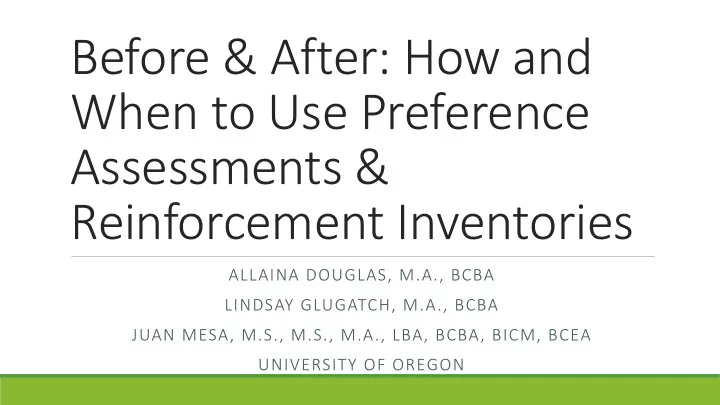

Before & After: How and When to Use Preference Assessments & Reinforcement Inventories ALLAINA DOUGLAS, M.A., BCBA LINDSAY GLUGATCH, M.A., BCBA JUAN MESA, M.S., M.S., M.A., LBA, BCBA, BICM, BCEA UNIVERSITY OF OREGON
Objectives The goal for getting students to work within the classroom and on their own Confusion of “preference,” “reinforcer,” and “reward” What is a preference assessment? What is a reinforcement inventory? When to use which assessment? Case examples
The Goal We want our students to be “intrinsically” motivated to learn. However, we know that, at first, this is not always the case. We also know, no one works for free. We need to meet them “where they are at” .
Some Common Strategies Preference assessments Reinforcer assessments Rewards ...But...wait? Those are not the same thing?
The Difference Preference Assessment Reinforcer Assessment Reward A way to determine if one or A variety of direct data-based Something given in recognition of more items, activities, persons methods used to determine if a one’s service, effort, or may function to increase the rate item, activity, or person achievement. of a desired behavior or behaviors functioned as a reinforcer when when delivered following the presented contingent on a target Says nothing about future occurrence of that behavior. behavior. The item is considered a frequency or personal reinforcer when future effects on preference. rate of responding increased. Avoid committing “Assume-a-cide”
Preference Assessments A way to determine if one or more items, activities, persons may function to increase the rate of a desired behavior or behaviors when delivered following the occurrence of that behavior. Types of preference assessments Paired Choice Multiple Stimulus Without Replace Free Operant
Paired Choice Consists of the simultaneous presentation of two items. Each item is matched with all other stimuli in the set. The items are rank-ordered in terms of high, medium, and low preference based on how many times a item is chosen.
Multiple Stimulus Without Replacement Multiple items are placed in front of the student. The student chooses an item. The item is not replaced and the remaining items are rearranged and the next trial begins. The items are ranked based on preference of which was selected first, second, third, etc.
Free- Operant Consists of the student getting free access to all hypothesized preferred items. Each time the student engages with an item, duration data is collected. The items are rank-ordered in terms of high, medium, and low preference based on how long the student engaged with an item.
Reinforcer Assessment A variety of direct data-based methods used to determine if a item, activity, or person functioned as a reinforcer when presented contingent on a target behavior. The item is considered a reinforcer when future effects on rate of responding increased. Reinforcer- the immediate delivery of an item, activity, or person contingent on a target behavior which increases the future frequency of the behavior.
Types of Reinforcer Assessments Concurrent Schedule Reinforcer Assessment “When two or more contingencies of reinforcement operate independently and simultaneously for two or more behaviors” (Cooper, Heron & Heward, 2007) Multiple Schedule Reinforcer Assessment “Consists of two or more component schedules of reinforcement for a single response with only one component schedule in effect at any given time” (Cooper, Heron & Heward, 2007) Progressive-Ratio Schedule Assessment “The response requirements for reinforcement are increased systematically over time independent of [student’s] behavior” (Cooper, Heron & Heward, 2007)
Sticky (but Common) Questions and Situations “Why does it matter if I call it a reinforcer or reward?” “Can it be all three?” “How often should I conduct these assessments?” “What if I can’t find a true reinforcer?” “What if is was a reinforcer earlier in the day, but no longer functions as one?”
Recap: Big Picture Using these procedures can help us find what currently motivates the student. Continually pairing what motivates the students with classroom activities will aid in that idea of “intrinsic motivation”. All students are different, make to use data-based decision and never assume.
allainas@uoregon.edu lglugat2@uoregon.edu jmesa@uoregon.edu
Recommend
More recommend